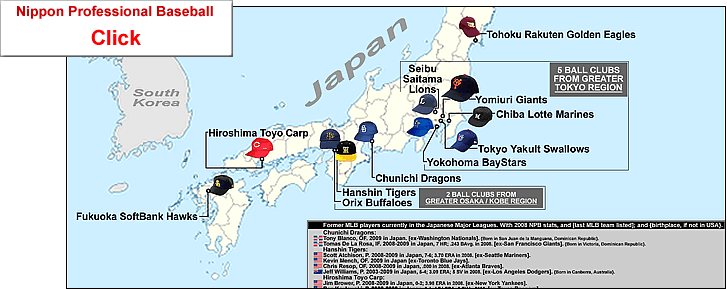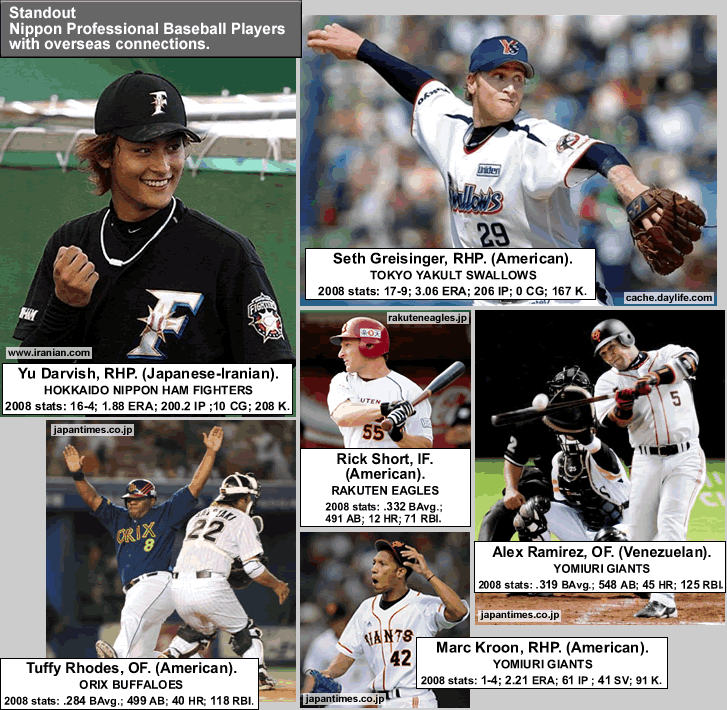
…
…
[Please note: I have a more recent post [from 2012], on baseball in Japan (NPB), here, Japan: Nippon Professional Baseball, 2012 – location map, with titles list, and 2011 attendance data / Plus an editorial on Japan’s baseball stadium deficiencies / Plus a short article on Japanese-born players in MLB.]
Nippon Professional Baseball was formed in 1950, as a re-organization of the Japanese Baseball League, which existed from 1936 to 1944, and 1946 to 1949. The current set-up has 12 teams in two leagues, the Central League and the Pacific League. The season is 144 games…18 games shorter than the Major League Baseball season . Inter-league play began in the NPB in 2005; teams play each team in the other league twice, all during a 7-week, mid-season segment. The top three teams in each league make the playoffs (called Climax Series, 1st and 2nd Stages), with 1st place getting a bye to the second round. The two winners of the Climax Series face each other in the Japan Series, a 7 game series.
There is a 4-player limit for foreign players (on the 25-man roster) per team. {See this, from JapaneseBaseball.com’s FAQ page.}/
To see a list of Japan Series wins, {click here}.
Last season, the Seibu Lions defeated the Yomiuri Giants in 7 games to win the Japan Series. Here is an article on the finale, from The Japan Times Online, from November 10, 2008 {click here}.
The ’08 Japan Series pitted the two most successful teams in Japanese baseball...
The Yomiuri Giants, of Tokyo, are far and away the most popular (revered would be more like it) team in Japan. They have won 20 Japan Series titles. They are often called the New York Yankees of Japan. The Giants are owned by the Yomiuri Group, a media conglomerate best known for it’s large national newspaper, the Yomiuri Shimbum. This newspaper is credited with having the largest circulation in the world, at approximately 14 million per day.
The Seibu Lions, also from the Greater Tokyo region, have won 13 Japan Series titles (although the franchise’s first three titles came when the ball club was located in Osaka). The Lions are located in Saitama, which is 18 miles northwest of downtown Tokyo. The club is owned by the Seibu Group. Seibu is a large department store chain. Over the winter break, the (now named) Saitama Seibu Lions unvieled new uniforms that nod to their past, as Osaka’s Nishitetsu Lions (three-time champions in the late 1950′s). In a radical shift from their day-glo powder blue gear featuring an animé-style Lion crest, the Lions now sport a Gothic-font L crest, with a pale shade of blue-black as their primary color, on their old-school style uniforms…a real retro look {see this (from jhockey.wordpress.com)}.
But to say that (like in Major League Baseball) the retro look in uniforms and ball parks is a trend here in Japan would be pushing it. There are still plenty of loud colors and animated-character-iconography in the uniforms and logos of Japanese ball clubs, thanks to the pervasive influence of animé and manga in Japanese culture. And there are still a plethora of stultifying plastic-turfed domed stadiums in Japan, although the Hanshin Tigers’ (“the Boston Red Sox of Japan”) park is nice {see this photo}, and the expansion franchise Rakuten Eagles’ park is hopefully a harbinger of things to come in the NPB {see this photo (by orimo @ flickr.com)} (the stadium’s embarrasing new name notwithstanding).
Nippon Professionasl Baseball clubs are, after all, just branches of the parent corporations, and their look is very much dictated by what sells in Japan. And animé and manga are everywhere in Japan, consumed by not just by teens and pre-teens, but by most every segment of society. The presence of corporations in the Japanese baseball world is rather pronounced, to the point that many of the teams’ names contain that of their ownership group, and the teams actively promote these corporate interests. And so you see many teams with crests featuring characters appropriate for pre-schoolers. And you see images like this ad {click here}, for the 2006 Japan Series between the Chunichi Dragons and the Hokkaido Nippon Ham Fighters. It looks like they are selling candy, not post-season major-league baseball, but that’s Japan.
Here is a brief, illustrated look at the 12 teams in Nippon Professional Baseball, from a site called Inventorsport.com… The Central League {click here}. The Pacific League {click here}.
-
The 2009 Nippon Professional Baseball season started Friday, April 3rd. Here is a report from Saturday, April 4th, from The Japan Times Online {click here}.
-
ESPN multi-media article on 6′ 5″, 21-year old pitching sensation Yu Darvish, of the Hokkaido Nippon Ham Fighters {click here}.
-
Thanks to the contributors to the pages at Wikipedia {click here (Nippon Professional Baseball)]. Thanks to the JapaneseBallPlayers.com site, for information on Japanese players currently in the MLB {click here}. Thanks to Yakyu Shop {click here}, for ball cap photos. Thanks to NPB.or.jp {click here}.
Thanks to the nice site called ‘Japanese Baseball Cards, An English Guide to Baseball Cards from Japan’ {click here}.
Thanks to the JapaneseBaseball.com site, for rules information, and stats on players {click here}. Thanks to Steve Levenstein at InventorSpot.com {click here}. Thanks to Yakult Swallows Home Plate site {click here}.
**[ Recommended ]** Thanks to Marinerds, etc. site (ex-Seattle girl’s blog about Japanese baseball) {click here}. Thanks to Japan, Hockey, Baseball, etc, site {click here}.
Thanks to TransPacificRadio.com {click here}; {their 2009 Central League Preview podcast, click here}.

